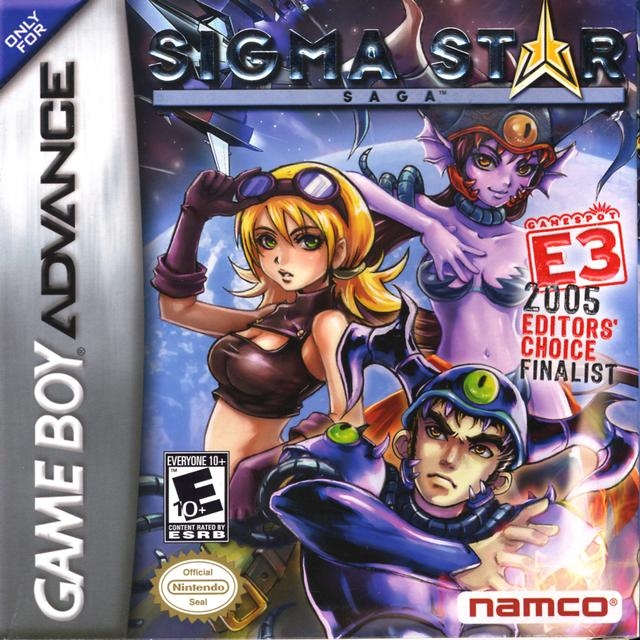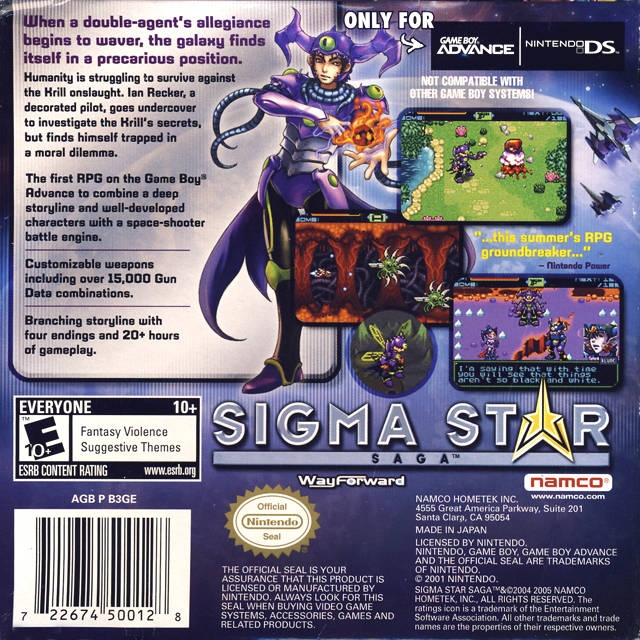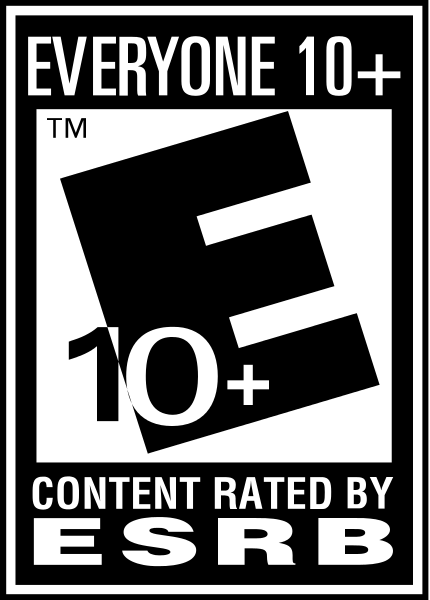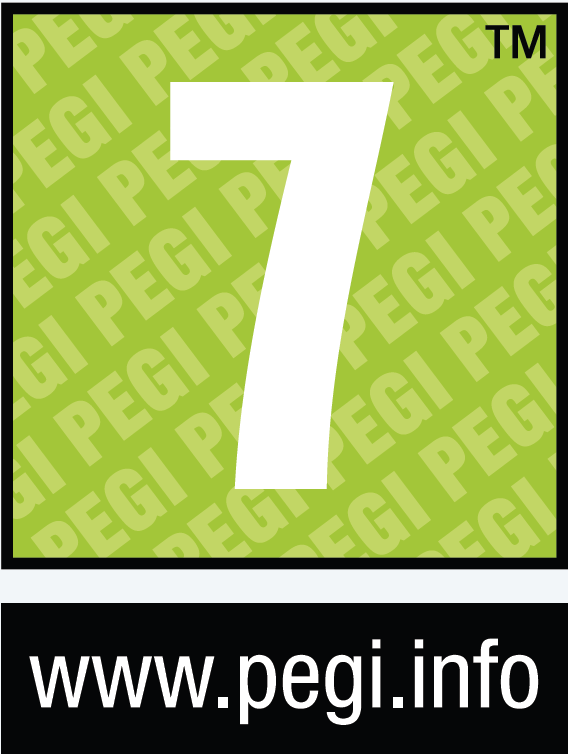Existing User Log In
New User Registration
Register for a free account to gain full access to the VGChartz Network and join our thriving community.





America - Front


America - Back



WayForward Technologies
Role-Playing
 08/16/05 Namco
08/16/05 Namco  (Add Date)
(Add Date) 06/23/06 Atari
06/23/06 Atari
| Owners: | 20 | |
| Favorite: | 2 | |
| Tracked: | 0 | |
| Wishlist: | 0 | |
| Now Playing: | 0 | |
16th Mar 2020 | 2,936 views
Game: Sigma Star Saga.
Platform: GBA.
Year: 2005/6.
Developer: WayForward Technologies
Genre: Shoot 'em up/RPG.

Throughout the years, finding a formula that works has been more difficult that it might seem at first glance. With the gradual evolution of hardware, and the more technical chances that endows, developers have tried mixing and matching different styles and genres, looking to add their best strengths while filing off some of their pet peeves. And this not only has allowed for the birth of many of gaming’s classics, but has also created new genres, that have, with time, also been mixed and matched. However, mixing two different genres needs a very clear vision, to avoid imbalances and design clashes. If this happens, instead of creating one game that uses multiple genres’ strengths and little to none of their weaknesses, we get a game that ends up with the worst of both worlds. And sometimes the mix feels like two separate and different games altogether. And this was my main though during my playthrough of Sigma Star Saga.
Sigma Star Saga is a shoot’em up/RPG game created by developer WayForward Technologies for the Game Boy Advance, and published by Namco in 2005 and Atari in 2006. The gameplay mostly revolves around two modes: your typical 2-D space corridor shooter, in which you move horizontally through different scenarios shooting anything that you come across, and a top down, more RPG-like mode in which you explore different worlds on foot and try to solve certain “puzzles”. Both sides are quite different from each other, and while one can feel what the developers were going for, certain choices make them clash frequently. The sidescroller part of the game is quite typical: you move left, right, up and down, and you either try to kill a certain amount of enemies or kill a single boss, all while traversing certain scenarios. This works pretty much as you can expect, with three options available to your weaponry: type of bullet shot, type of firing mode, and special effect applicable. You can combine different variations to spice up the game, and to counter different kinds of enemies. Those that fly regularly are dealt differently that those that stick on the ground or the ceiling. And there can be quite a lot of enemies on the screen, so you better choose wisely. You have two firing options, interchangeable during the combat, to avoid being stuck with an unfavorable situation. Some combinations are much better than others, though, and you will never end up using them, while others are practically mandatory (in my personal opinion the vampire mode is a lifesaver against bosses, especially combined with high shooting rates). Also, you have available smart bombs, which will wipe out all enemies on screen. They are amazing, but mostly pointless on bosses, so save them for regular engagements. The scenarios you have to travel with are a bigger concern, though. While some of them are as easy as having little to no obstacle, others are made of very thin corridors, which allow little to no movement, all while moving up and down, avoiding natural obstacles and shooting enemies that travel in a straight line against you. Sometimes the game will start you so close to the borders of the map that you will immediately crash and lose damage, which was a nasty surprise in one or two occasions that I was running low on health. It also has problems with the types of ship you use, which is randomized. Every time you start an engagement, you are given a random ship, ranging from small and nimble to massive, unwieldy spacecraft that can barely move at all. And considering how difficult maneuvering through terrain can be, you can imagine which scenario you want to find yourself in. There is very little difference in stats between the ships (the bigger they are, the stronger and more resistant they are, but not by much) so why even bothering with different types. Or better yet, if you are going to bother, why not allow a player choice?
The other game mode, the one RPG-like, is not quite as fleshed out as it could’ve been. It’s the mode in which the story mode will happen most of the time, going from place to place while searching for clues, accomplishing missions and finding stuff. You can find stuff like the smart bombs, life packs and the necessary data packs that include the different shooting modes and upgrades. You can also fight some enemies, though you never need to fight anything boss-like in this mode, which feels like a waste, and the few times the game gets close to this are… underwhelming. In general the missions that you need to accomplish in the different planets (your typical forest planet, ice planet, sand planet…) you explore are quite simple, and the design aims to favor as much backtracking as possible, possibly as a resource saving measure. Which clashes horribly with the main flaw of the game.
The main problem of the game is pacing. Every single aspect of the game either takes too long or too short time. And nothing better exemplifies this than its random encounter system. This is something typical from RPGs, and while it’s not gamer’s favorite mechanic, it still endures in most JRPGs. However, the problem with this game’s random encounters is that you can’t quit them. You have to finish every single one of them to move forward. And if you don’t see the problem right away, just imagine Pokémon or Final Fantasy, but taking away the option of running away from random encounters. The sheer amount of time wasted to go from point A to point B is staggering, and it becomes incredibly grating. You can’t move from screen to screen without having to finish two or three small missions, mostly focused around things like killing 20 enemies and such. And if you are trying to explore the map, or you took the wrong turn, or you are trying to hunt for all the data boxes, you will become horribly sick of the side scrolling events. Which is bad because they are half of the game. If you end up hating the most important part of your core game, you are doing something wrong. And then you find the bone hunt in the desert planet, looking for fossil bones with the scanner item, with missions such as “defeat 99 enemies in one level”, and your patience breaks. It became a time sink, and a horrible one at that. An endless loop that got in the way of any enjoyment. And even then, there are some random encounters in the game that are glitched, and won’t just end once you’ve accomplished your mission, trapping you on an endless loop of just moving forward, which can only be broken by killing your character against the walls and losing whatever progress you’ve managed to get done! The funny thing about this is that the game has a level up mechanic, in which you can increase the ship’s toughness and strength, but why bother? The fact you have to fight every single random encounter means you won’t ever be underleveled. Unless you know exactly where you are going at every step of the game, you will roll over your enemies due to the sheer amount of involuntary grinding you’re doing, making most of the game incredibly easy (keyword being most, the early game is quite difficult and punishing, but once the grinding kicks in, it’s all over). So why even keep it in the game?
The story also has pacing problems. Considering that RPGs usually have long stories, and most of the time the game is too focused in the random encounters to bother with the story they were trying to tell. The story revolves around Recker, a pilot that gets embroiled in a planetary war against the alien species Krill, and having to play as an undercover agent to try and find a secret plan they might be scheming. The Krill have attacked the Earth in the past, and now they are coming again, and so Recker needs to infiltrate their ranks to find the truth about their secret weapon. Along the way, he finds Psyme, a female krill pilot, and Scarlett, a human scientist, and they have to uncover some secret conspiracy affecting both humanity and the Krill. Now, if the gameplay takes the very slow route, the story is in constant overdrive. The sheer speed of the story means that it will just jump from plot point to plot point seemingly at break neck speed. The romance between Psyme and the main character just appears one scene, and in the next they are introducing a love triangle between the three main characters. I suppose they felt this pace was balanced with the slow gameplay, but the end result is dizzying. The fact most shoot’em all games are relatively short clashes with the need for an RPG to have enough time to develop its story, and as such, it doesn’t work for neither side. The story itself is fun but overly clichéd, they tried to go for a serious tone mixed with some comedy bits, which I think it works well enough. If you’ve ever seen any space opera, you know what’s going to happen every single time. And even then they’ll pull a random scene that throws you for a loop and makes you laugh at the absurdity. The game only has six levels, and has multiple endings, but they are so short they are barely worth the need to replay the whole game (alongside all of the grinding) to get them.
Presentation-wise, it’s ok. It feels like one of the last GBA games released for the system, especially taking into consideration it’s WayForward we’re talking about. Their sprite work was, and still is, very good, so it looks quite well in spite of the hardware. Sadly, the monster design leaves a lot to be desired, which is odd. It’s not like the designs aren’t good, it’s because the choices for enemies are quite poor. You could have chosen cool alien monsters to fight against, but instead most designs are quite shapeless, and too many of them are just floating rocks. And you can do so much with the design of such enemies. The overworld is designed well, although the level design becomes annoying fast due to the previously mentioned random encounters. Music is all right, but nothing really special.
Sigma Star Saga feels like experimenting with a good idea and getting poor results. I feel like they went too far in many aspects and not far enough in most of them. The amount of repetitive content instead of actual, plot moving content, is too bothersome to just forget about it. Hell, cutting the random encounters by half (or just allowing you to skip it) would have fixed a ton of problems. They would’ve had a shorter game, yes, but a much better experience.
Score: 4/10
| Total Sales |
0.00m
Japan |
0.04m
NA |
0.01m
Europe |
0.00m
Others |
0.05m
Total |